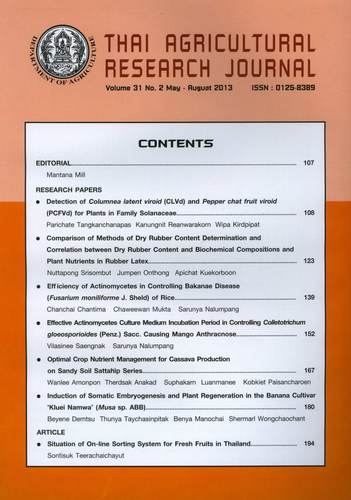Detection of Columnea latent viroid (CLVd) and Pepper chat fruit viroid (PCFVd) for Plants in Family Solanaceae
DOI:
https://doi.org/10.14456/thaidoa-agres.2013.4Keywords:
Columnea latent viroid (CLVd), Pepper chat fruit viroid (PCFVd), Solanaceae, duplex RT-PCR, biological indexing plants, internal controlAbstract
Columnea latent viroid (CLVd) and Pepper chat fruit viroid (PCFVd) are plant pathogens in viroid group causing serious damage in the Solanaceae, such as tomato, potato and pepper. CLVd and PCFVd can cause high yield losses in potato crop production by causing spindle-shape and elongated tuger, These viroids cause very serious damage in tomato and peper crop, such as stunting of stems, and reduction in fruit size and leaning of seeds. In addition, these viroids can be very easily transmitted through contaminated agricultural tools and equipments. Moreover, any symptoms are not shown in some plant species throughout the plant life (latent symptom) that makes difficult to completely eliminate (eradication), which causes viroids, are interesting and emphasized for plant quarantine agencies in developing countries for present. Nonetheless, identification of these two viroids by symptoms in the economic crops can not be done, since the similarity. For these reasons, the development of standard detection methods for these two viroid species is necessary to prevent viroid from being contaminated from foreign countries, and to meet the export condition. The results showed that the bolo maka plant (Solanum stramonifolium) can be used as biological indexing plant for primary viroid identification and differentiation between CLVd and PCFVd. In addition, the NAD primers (Nad2.1a:GGACTCCTGACGTATACGAAGGTC/Nad2.2b:AGCAATGAGATTCCCCAATATCAT) can be used as internal control, by RT-PCR detectiong on plant NdhB gene and showed amplification band clearly at 188 base pairs. The PC-2 primers (cP2: TGTTTCWRCDEEEATTACTCCTG/ Hpc2: GGGTTTTCACCCTTCCTTTC) and the PCFVd primers (cPCFVd: AGTTGTATCCACCGGGTAG/hPCVd: GACAGAGGTGCTTTTTCTTC) can be used for CLVd and PCFVd diagnosis specifically, and displayed amplification band clearly around 370 and 350 base pairs, respectively. Finally, duplex RT-PCR also can be used effectively when uses PC-2 or PCFVd primers concentration for .02 M and NAD primers concentration for 0.1 M for each reaction
Downloads
Published
How to Cite
Issue
Section
License
Copyright (c) 2017 วารสารวิชาการเกษตร (Thai Agricultural Research Journal)

This work is licensed under a Creative Commons Attribution-NonCommercial-NoDerivatives 4.0 International License.
Thai Agricultural Research Journal



